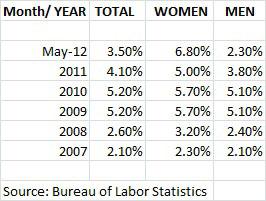IT unemployment pales in comparison with the national unemployment rate -- so long as you're not a woman. In May, for example, the unemployment rate for women in computer and mathematical occupations stood at 6.8 percent, whereas men faced a mere 2.3 percent unemployment rate, according to figures from the U.S. Bureau of Labor Statistics. A one-month blip you may ask? Apparently not. Last year's figures were only mildly better. Here's a look at computer and mathematical unemployment rates going back to 2007 :

What Gives?
It's a toughie. The Bureau of Labor Statistics offered a just the facts, ma'am response to the unemployment rate. And economists and IT women's groups also noted it was a tough call as to why the gap between women and men would be so large. Nonetheless, they offered up some interesting perspectives. "We do know from research and from women's personal experiences that they are sometimes directed into, or decide, to take on project management or similar kinds of roles and that in some companies these roles are less valued and can be among the first to be laid off," says Catherine Ashcraft, a senior research scientist with the National Center for Women & IT at the University of Colorado. She further added: "I've heard both women and corporate executives talk about how this trend has unwittingly resulted in more women being laid off in recent economic times. It's not that anyone intends for this to happen but it becomes a systemic pattern that company leaders need to be aware of in order to make sure that they don't unwittingly diminish the creative and innovative potential of a diverse workforce." Bodhi Ganguli, an economist with Moody's Analytics, offered up another possible explanation for the gap in IT unemployment between the sexes. "Layoffs in technology companies have been in areas where more women are traditionally employed - helpdesk support, administrative functions, certain areas of programming, middle management and project management," Ganguli says.
Devil is in the Detail
Here's some good details from the Bureau of Labor Statistics on how the unemployment figures are calculated:
- The Government conducts a monthly sample survey called the Current Population Survey (CPS) to measure the extent of unemployment in the country.
- There are about 60,000 households in the sample for this survey. This translates into approximately 110,000 individuals, a large sample compared to public opinion surveys, which usually covers fewer than 2,000 people.
- Every month, one-fourth of the households in the sample are changed, so that no household is interviewed more than 4 consecutive months. After a household is interviewed for 4 consecutive months, it leaves the sample for 8 months, and then is again interviewed for the same 4 calendar months a year later, before leaving the sample for good.
- This procedure results in approximately 75 percent of the sample remaining the same from month to month and 50 percent from year to year.
Jim Walker, an economist with the bureau's Division of Labor Statistics, says in an email interview:
Typically the Bureau of Labor Statistics (BLS) would not publish an unemployment rate for an occupation if the labor force was less than 75,000 in monthly data. In the case of computer and mathematical occupations in May 2012 the denominator (labor force) of the unemployment rate calculation is sufficient for both men and women. However, it is important to remember that there were only about 36 unemployed women included in the survey and 33 men. The rule of thumb is that 1 person in the survey represents about 2,000 people in the tabulated numbers. (Men unemployed 65,000/2,000=33, Women unemployed 72,000/2,000=36)
While the raw number of unemployed computer and mathematical women and men are roughly the same, the percentage of women unemployed may loom larger because the potential size of IT women in the survey pool may be smaller. "Because there are significantly fewer women in technology than men, the percentages for women can also fluctuate more," Ashcraft surmised.
Advice for the Bearer of Pink Slips The next time your IT company is gearing up for another round of pink slips, they may want to take Ashcraft's advice to heart: "Anyone in a position to influence these kinds of decisions should keep track of patterns in workforce reduction and be aware of any potential patterns that tend to disproportionately affect women or other groups of people," she says. "This means not waiting for it to be brought to their attention but rather diligently looking to see if these patterns are occurring."
Related Links


![Go to article IT Women See Unemployment Gap Widen [DiceTV]](/binaries/small/content/gallery/dice/insights/2012/07/dicetv-unemployment.jpg)
